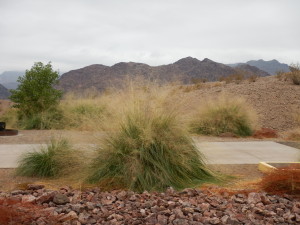
Alkalai sacatone grass is a beautiful component to any landscape, particularly in areas with extreme environmental conditions.
By Alice Newton
Alkalai sacatone grass, Sporobulus airoides, is also known as giant sacatone, dropseed, alkalai dropseed, or finetop salt grass. It is a tough perennial bunchgrass with flat, quarter inch wide leaves, commonly growing three to four feet high and about as wide.
Although the plant is very tolerant of soils with high alkalinity, salinity and pH, the leaves are fairly soft and suitable for planting near high-traffic areas. The inflorescence is an attractive, open panicle approximately 18 inches tall held above the plant, usually appearing in late spring or early summer. At maturity, the small seeds drop from the panicle and are easily collected in containers.
This species is found in the wild all over the western United States and Mexico, often in alkaline flats, prairies, and sandy plateaus. In deserts and semi-desert areas they are common in springs and washes with seasonal flow. Of all the Sporobolus species, S. airoides is the most tolerant of extreme soil chemistry and moisture conditions.
Sacatone grass is tolerant of moderate grazing and is good forage for horses, sheep, cattle, deer and small mammals. Birds and waterfowl (game and non-game) enjoy the seeds and tender young shoots, especially after fires. It is fire tolerant, but can be killed if fire is severe or occurs frequently (more often than every two to four years). Summer fires are more damaging than winter fires.
After establishment, it is tolerant of both drought and water inundation, making it suitable for a wide range of landscape applications. However, it does not grow well in shade, and so should be planted in open areas. If not butchered with short “haircuts”, their leaves remain long and flowing for several years.
It reproduces from seeds, tillers, and root divisions. The seeds remain viable for many years without special storage requirements, and forage plants should be sowed in the late spring or early summer when soil temperatures are fairly high and the probability of precipitation is greatest. Established plants can survive without irrigation in areas with 12 to 18 inches of precipitation per year.
For landscape plants, lightly press seeds into fine growing media (coir or peat) in a flat with good drainage in the greenhouse. Keep the medium moist but not wet, in good light. Bottom heat will speed germination, but is not necessary. The germination rate is excellent and will occur in one to two weeks.
About three weeks after sowing, carefully transplant individuals into larger containers (cells or small pots) with well-draining soil, and keep moist. Mix a slow-release, low-nitrogen turf fertilizer with micronutrients in the soil or apply about a week or 10 days after transplanting.
After two to three months these plants may be moved up to one gallon containers or placed in the field. Root divisions should be started in the greenhouse and treated as the seedlings above, however, they may be placed directly in the field if conditions are excellent (warm with consistent moisture).
Sacatone grass is an excellent replacement for many landscape grasses that are becoming recognized as invasive or have been placed on states’ noxious weed lists. For example, green fountain grass (Pennisetum setaceum) is a common (and frankly overused) landscape plant that is listed as a noxious weed in the state of Nevada. It has been documented as an invader of natural landscapes in southern Nevada and western Arizona, particularly in areas just north of Laughlin, Nevada, and Bullhead City, Arizona.
Another Pennisetum species, buffel grass, is invading natural landscapes in the Sonoran Desert near Tucson and other high elevation sites. Both buffel and fountain grass displace native plants (not just native grasses) and change both the intensity and frequency of wildland fires.
Recently, several governmental agencies have formed a Southern Nevada Cooperative Weed Management Association (SNCWMA) to devise strategies to help combat invasive species in southern Nevada. Their Fountain Grass Control Initiative is a pilot program designed to help property owners and managers replace their now-illegal fountain grass with alkalai sacatone grass.
The owner digs up and brings in the fountain grass to an exchange site, and in return receives a one-gallon size sacatone grass with care instructions, free of charge. There is no limit to the number of plants that can be exchanged, as the whole point of the Initiative is to eliminate as many green fountain grass plants as possible from southern Nevada landscapes.
The exchange plants are now being grown at Song Dog Native Plant Nursery located Lake Mead National Recreation Area from locally-collected seed. This exchange program is still being organized, but will be implemented first in the Laughlin and Bullhead City area. If you would like more information on the SNCWMA or the Fountain Grass Control Initiative, please contact Lauren Brown at s.nv.cwma@gmail.com.
Alkalai sacatone grass is a beautiful component to any landscape, particularly in areas with extreme environmental conditions. It can replace many invasive non-native grasses that are now causing a lot of problem in natural areas and landscapes. It can be planted near high-traffic areas, and will attract song birds and other seed-eating wildlife. It has few or no pest issues, and is highly drought tolerant. What a fine ornamental grass for any native plant garden or landscape!
As the Vegetation Program Manager, Alice Newton is responsible for weed and rare plant management, arid land restoration and Song Dog Native Plant Nursery operations for the National Park Service at Lake Mead National Recreation Area.
